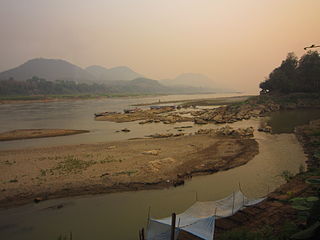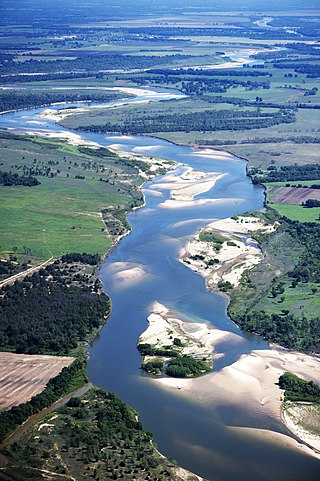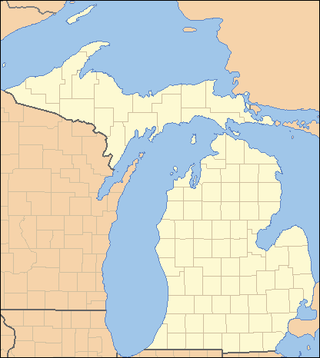| River | Length | Drainage area | Average discharge (m³/s) | Mouth | Notes | Reference | Rank |
|---|
| Amazon River | 6,937 km (4,310 mi)
6,992 km (4,345 mi) | 7,050,000 km2 (2,720,000 sq mi) | 219,000 m3/s (7,700,000 cu ft/s) | Atlantic Ocean | Second-longest and largest river in the world, undammed as well as unbridged, does not form a delta while joining the sea due to adequate thrust of river water to overcome the sea water wave and tidal thrusts. | | 1 |
| Lena River | 4,472 km (2,779 mi) | 2,500,000 km2 (970,000 sq mi) | 17,000 m3/s (600,000 cu ft/s) | Arctic Ocean | Longest undammed river in Asia. | | 2 |
| Amur – Shilka – Onon | 4,197 km (2,608 mi) | 1,855,000 km2 (716,000 sq mi) | 11,700 m3/s (410,000 cu ft/s) | Strait of Tartary | | | 3 |
| Mackenzie – Slave – Athabasca | 3,403 km (2,115 mi) | 1,805,200 km2 (697,000 sq mi) | 10,700 m3/s (380,000 cu ft/s) | Arctic Ocean | The Peace – Finlay system would extend even longer from the head of the Slave but there are dams on the Peace. | | 4 |
| Nizhnyaya Tunguska River | 2,989 km (1,857 mi) | 473,000 km2 (183,000 sq mi) | 3,680 m3/s (130,000 cu ft/s) | Yenisei River | The Russian government is planning to build hydro dams on the river within the next few years. | | 5 |
| Salween River | 2,815 km (1,749 mi) | 324,000 km2 (125,000 sq mi) | 6,700 m3/s (240,000 cu ft/s) | Andaman Sea | Longest undammed Southeast Asian river. Burma is planning to build the Tasang Dam and several others. | | 6 |
| Paraguay River | 2,549 km (1,584 mi) | 1,150,000 km2 (440,000 sq mi) | 4,550 m3/s (161,000 cu ft/s) | Paraná River | | | 7 |
| Amu Darya – Panj | 2,500 km (1,600 mi) | 534,700 km2 (206,400 sq mi) | 1,330 m3/s (47,000 cu ft/s) | Aral Sea (former) | Although undammed, heavy diversion through canals causes the river to frequently dry up without reaching its mouth. Tajikistan is planning to build a hydroelectric dam on the Panj River. | | 8 |
| Aldan River | 2,273 km (1,412 mi) | 729,000 km2 (281,000 sq mi) | 5,060 m3/s (179,000 cu ft/s) | Lena River | | | |
| Rio Negro | 2,230 km (1,390 mi) | 691,000 km2 (267,000 sq mi) | 29,300 m3/s (1,030,000 cu ft/s) | Amazon River | | | |
| Vitim River | 1,978 km (1,229 mi) | | | Lena River | | | |
| Indigirka River | 1,726 km (1,072 mi) | 360,400 km2 (139,200 sq mi) | 1,810 m3/s (64,000 cu ft/s) | Arctic Ocean | | | |
| Fraser River | 1,375 km (854 mi) | 220,000 km2 (85,000 sq mi) | 3,475 m3/s (122,700 cu ft/s) | Pacific Ocean | | | |
| Kuskokwim River | 1,165 km (724 mi) | 120,000 km2 (46,000 sq mi) | 1,900 m3/s (67,000 cu ft/s) | Bering Sea | | | |
| Back River | 1,150 km (710 mi) | | | Arctic Ocean | | | |
| Anadyr River | 1,150 km (710 mi) | 191,000 km2 (74,000 sq mi) | 2,020 m3/s (71,000 cu ft/s) | Gulf of Anadyr | | | |
| Liard River | 1,115 km (693 mi) | 277,100 km2 (107,000 sq mi) | 2,434 m3/s (86,000 cu ft/s) | Mackenzie River | | | |
| Yellowstone River | 1,114 km (692 mi) | 181,300 km2 (70,000 sq mi) | 380 m3/s (13,000 cu ft/s) | Missouri River | Longest undammed river in the contiguous United States. | | |
| Maya River | 1,053 km (654 mi) | 171,000 km2 (66,000 sq mi) | 1,180 m3/s (42,000 cu ft/s) | Aldan River | | | |
| Fly River | 1,050 km (650 mi) | 76,000 km2 (29,000 sq mi) | 6,500 m3/s (230,000 cu ft/s) | Gulf of Papua | Largest completely undammed river system in the world | |
| White River | 934 km (580 mi) | 26,000 km2 (10,000 sq mi) | 16 m3/s (570 cu ft/s) | Missouri River | |
| Tanana River | 916 km (569 mi) | 113,960 km2 (44,000 sq mi) | 1,172 m3/s (41,400 cu ft/s) | Yukon River | | | |
| Thelon River | 900 km (560 mi) | 142,400 km2 (55,000 sq mi) | | Hudson Bay | | | |
| Salmon River | 684 km (425 mi) | 36,000 km2 (14,000 sq mi) | 310 m3/s (11,000 cu ft/s) | Snake River | | | |
| Stikine River | 610 km (380 mi) | 52,000 km2 (20,000 sq mi) | 1,580 m3/s (56,000 cu ft/s) | Pacific Ocean | | | |
| Skeena River | 570 km (350 mi) | 54,400 km2 (21,000 sq mi) | 1,760 m3/s (62,000 cu ft/s) | Pacific Ocean | | | |
| Susitna River | 504 km (313 mi) | 52,000 km2 (20,000 sq mi) | 1,400 m3/s (49,000 cu ft/s) | Pacific Ocean | Alaska is planning to build a hydroelectric dam on the river at Devil's Canyon. | | |











